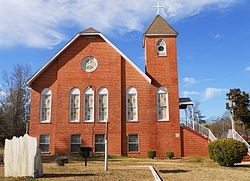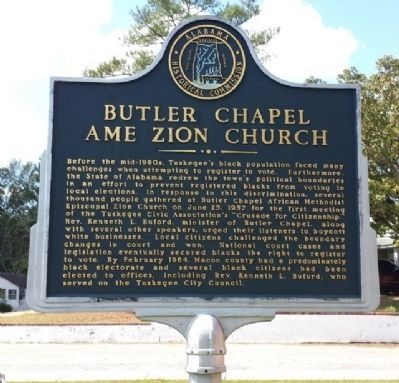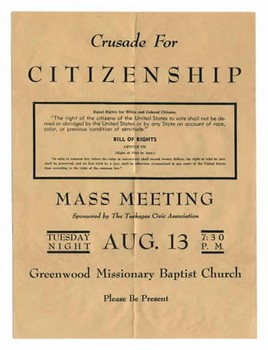Butler Chapel AME Zion Church
Introduction
Text-to-speech Audio
Images
Current Image of the Butler Chapel AME Zion Church.

Historic Marker honoring those who participated in the Crusade for Citizenship meetings that took place at the Church.

Poster for the Crusade for Citizenship from the collection of William Levi Dawson at Emory University

Backstory and Context
Text-to-speech Audio
After being disenfranchised by the white majority of Alabama, African Americans were fed up with their treatment and decided to seek change. However, their change was much different than the way change and revolution had been sought in the past. Instead of attacking their adversaries with guns in their hands and hatred in their hearts, like so many of us are accustomed to, the African Americans who wanted change met peacefully at Butler Chapel African Methodist Episcopal (AME) Zion Church on June 25, 1957. This meeting spurred a series of meetings that eventually gave way to grass roots political activism that became known as the Crusade for Citizenship.
Reverend Kenneth L. Bufurd, pastor of Butler Chapel AME Zion Church, was the unofficial leader of the movement. He and other clergy urged their congregations and fellow African Americans to boycott white businesses and protest the political leaders who had kicked them to the curb. Upon hearing of the movement, Dr. Martin Luther King Jr., sent a letter of encouragement to the leaders and participants of the protests, as well as a donation to the Crusade for Citizenship. The movement was undeniably picking up steam and was heading towards re-adoption of the once discarded African Americans.
Although the NAACP was not directly involved with this movement, the movement nonetheless made its most ground in true Thurgood Marshall fashion by taking what they thought was unjust laws to court. Eventually, the protestors prevailed and the gerrymandering disenfranchisement of African Americans was put to rest. As the marker states, by the mid 1960’s Macon County Georgia was made up of a predominantly Black electorate, which had elected Black officials. Included on this list Black elected officials was the leader of the Crusade for Citizenship, Reverend Kenneth L. Bufurd. The crusade was a success.
The Butler Chapel AME Zion Church was added to the Alabama Register of Landmarks and Heritage in 1985. The Butler Chapel was then added to the National Register of Historic Places in 1995. The Alabama Historical Commission erected this marker in 2009 to honor those who participated in the events.
Cite This Entry
Blake, Austin. "Butler Chapel AME Zion Church." Clio: Your Guide to History. February 24, 2016. Accessed August 21, 2025. https://theclio.com/tour/1730/1/reverse

